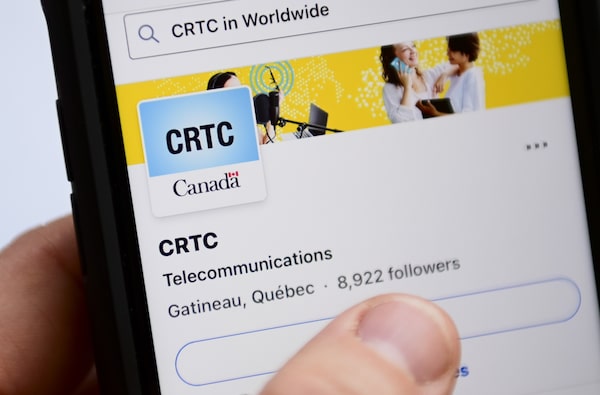
MVNOs offer cheaper cell service, as they don’t have to build and maintain their own networks. However, the CRTC requires them to build their own infrastructure within seven years.Sean Kilpatrick/The Canadian Press
Canada’s telecom regulator has released the details of its mobile wireless carrier framework, opening the doors for eligible regional companies to negotiate with incumbents to access their cell networks and offer competitive services.
The terms and conditions fill in the details of a 2021 policy from the Canadian Radio-television and Telecommunications Commission, which required incumbents to do business with mobile virtual network operators (MVNOs) that met certain criteria. As of now, incumbent mobile operators must accept requests from regional carriers to buy space on their networks.
An MVNO is a carrier that doesn’t own its own wireless network and offers service by piggybacking on the network of an incumbent. Typically, they offer cheaper cell service, as they don’t have to build and maintain their own networks. However, the CRTC requires them to build their own infrastructure within seven years.
The new network access rules are part of the federal government’s efforts to bring down cellphone bills in Canada by encouraging smaller entrants in the market.
In the 96-page document published on Wednesday, the CRTC laid out the eligibility criteria, as well as how companies would be required negotiate prices, and other requirements for incumbents. In Canada, incumbents include Bell Canada BCE-T, Rogers Communications Inc. RCI-B-T, Telus Communications Inc. T-T and Saskatchewan Telecommunications.
While some experts say the CRTC’s terms have provided an avenue for more competition, others argue they will lead to further standstill.
There is also yet no consensus as to whether the terms are more favourable to incumbents or the regional MVNOs. The terms and conditions emerged via suggestions from the incumbents. However, the CRTC notes several instances where it rejected provisions that would restrict MVNOs’ eligibility.
The CRTC has determined that to apply, companies must own spectrum in the region where they hope to operate, be registered with the commission as a wireless carrier, have a home public mobile network somewhere in Canada, and actively offer mobile wireless services commercially to retail customers. Companies who don’t meet these criteria can still approach incumbents, but those incumbents won’t be required to negotiate with them.
The CRTC did not specify rates – that will be up to the MVNOs and the incumbents, with final-offer arbitration by the CRTC if negotiations fail. Those rates must be open for renegotiation every two years at minimum.
The entrants will have only seven years to build their own infrastructure – after that date, incumbents are no longer required to provide access to their networks.
The terms and conditions are in line with the regulatory policy published last year, and with the CRTC’s push for facilities-based systems, in which telecom companies invest in their own physical infrastructure rather than operating through the networks of others. Such investments are expensive, and the seven-year piggyback period allows those carriers to make income to fund their network building.
“Overall, I think the commission has tried to preserve the incentives for continued investment,” said Mark Goldberg, head of telecom consultancy Mark H. Goldberg & Associates Inc. Nonetheless, he noted, despite the many details in the document, what happens at the end of the seven years is unclear.
According to Anthony Lacavera, founder of Freedom Mobile (previously Wind, now owned by Shaw Communications Inc.), the terms indicate to new mobile carriers with their own infrastructure that they won’t have to compete with MVNOs who can resell wireless access indefinitely without investing in their own network.
“It’s signalling to somebody like T-Mobile, ‘If you come into Canada, you don’t have to be worried about artificial competition,’” he said. “Canada needs a competitor like that to push Bell, Telus and Rogers to lower prices and improve on customer experience.”
Spokespeople from Bell, Telus and Rogers said their companies are reviewing the terms.
For Vidéotron, a Quebec-based cable company owned by Quebecor Media Inc. that has wireless ambitions, the terms were positive. Chief executive officer Pierre Karl Péladeau said in a statement that he expects “the incumbents to act in good faith, quickly negotiate the terms of a wholesale access agreement, and allow Vidéotron access to their networks as soon as possible.”
The terms were also encouraging for Montreal-based cable company Cogeco Inc., even though it does not yet meet all the eligibility criteria. While the company already owns spectrum in the region where it hopes to begin mobile operations, it is not yet a commercial mobile wireless operator in Canada. In a statement, Cogeco spokesperson Youann Blouin said the company would take the new requirements into account, but overall saw the terms as “a positive step” in the development of Canada’s MVNO framework.
However, some say the strict eligibility requirements cut off opportunity for competition.
“At the end of the day, while the decision provides some benefits to regional carriers, the overall wholesale MVNO regime remains highly restrictive and only available to regional carriers that are already providing mobile wireless services,” said Geoff White, executive director of the Competitive Network Operators of Canada, the industry association representing independent internet service providers.
Some have also pointed out that the two-year renewal clause could create significant administrative delays.
“That seems like a potentially catastrophic failure of the framework,” said Andy Kaplan-Myrth, vice-president of regulatory affairs at TekSavvy Solutions Inc.
“The CRTC has historically taken a long time to come to decisions on arbitration. If the incumbents can’t agree on rates, this could still take years to have any impact.”
In a note to investors, National Bank analyst Adam Shine said MVNO deals could be struck as early as the first quarter of 2023, but he would be surprised to see any MVNO service launched before next summer.